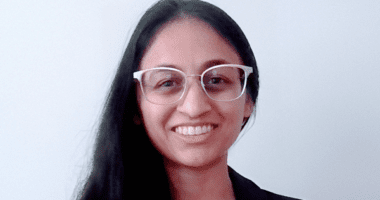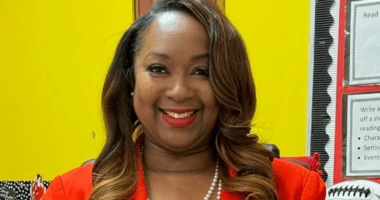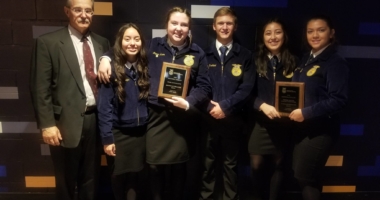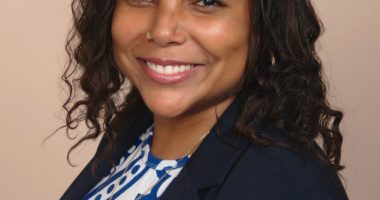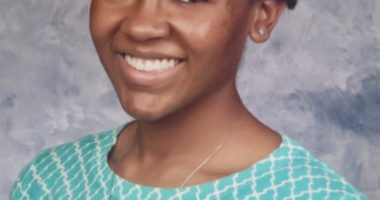Both Sides of the Gap
Ashley Lamb-Sinclair is the 2016 Kentucky Teacher of the Year. She teaches English and creative writing at North Oldham High School, a high-achieving school northeast of Louisville where 97 percent of the school’s mostly white, middle and upper class students graduate, and 90 percent move on to college, part-time or full-time. Currently serving as teacher-in-residence with the Kentucky Department of Education, Ashley reflects on her teaching experience to show how educators in schools like North can and should help advance equity.
In North Oldham High School’s library on a chilly December morning, 35 students of color — new to the country — crowd in with a hundred or so NOHS students. Along with the other teachers in the room, I find a corner from which to observe as the students of color begin sharing their stories.
One of our guests was born in a refugee camp. Another speaks of traveling from country to country, avoiding war and political unrest. I look around the packed room and watch as my students listen intently to stories that minutes before they didn’t realize existed. They are captivated. And they are listening.
The refugee and immigrant students didn’t show up here by accident. Their visit was two years in the making. It began when I took my honors sophomore English class to the local ESL Newcomer Academy in the neighboring district. I am required by my curriculum to teach mostly white, suburban students how to argue about global issues, and I thought it nearly impossible for them to do so without having a conversation with someone who had firsthand experience with some of those issues. My students spent the day bonding with the Newcomer students over music, and they shared troubling stories with one another. When we left that day, my students told me it was the best thing that they had ever experienced in school. Ever. We went back to Newcomer Academy again this year, and it was my students — not me — who asked for the Newcomers to come tell these stories to their peers back at school.
There is power in a story. My own has been tumultuous. I am from poverty. I have witnessed addiction and drug abuse and experienced the ever-present tap dance that comes with living from paycheck to paycheck. For these reasons I’ve sought positions in high-poverty schools. These are my people.
So I initially felt out of place teaching in an affluent school district. Before, my students were mostly students of color who would look at me with new admiration when I shared my own stories of struggle. When I first began teaching at my current school, those same stories were met with raised eyebrows. I reached a point where I thought it best to stop telling them. I started to approach my work with this new demographic from a completely academic standpoint — to only share with my students that I thrived because I “worked really hard.”
I tried to be that person until I realized I was hurting my students by not sharing my story and the stories of my former students. I was essentially telling them a lie.
When I sheltered my students in this affluent, mostly white school from the experiences of others from different ethnicities and economic backgrounds, I did them a disservice. I acquiesced to ignorance. I agreed that it was acceptable for them to never know the struggle of being poor or being a person of color or being in a situation with limited opportunities. And I also realized that my new students were not only in need of these types of experiences, but open to them.
When I began my teaching career, I wanted to offer my struggling students the world of education because it had so drastically transformed my own life. Looking at it honestly, I walked into those schools feeling like I had a right to stand before classes filled with primarily low-income students and students of color and hand them the keys to the kingdom. I fancied myself LouAnne Johnson or Erin Gruwell. But I quickly learned that growing up poor and white is a vastly different experience from growing up poor and black. I felt my students begin to question my naive speeches to follow your dreams. Because, like Peggy McIntosh writes in “White Privilege: Unpacking the Invisible Knapsack,” “I [could] think of many options, social, political, imaginative or professional, without asking whether a person of my race would be accepted or allowed to do what I want to do.” My students, however, often could not.
I hit that wall and I did what I always do, which is to be vulnerable. I told them, “I may have been poor, but I don’t know what it’s like to be poor and black. Period. And I won’t pretend I do. But I’m going to think about it. I’m going to ask my white friends to think about it. And I will listen when you tell me what it’s like to be you. And I will share that with others.” My mostly black, mostly low-income students perked up when I said these words. I admitted to them that I wasn’t there to save them but to listen and try to teach them in a way that mattered to them.
But in my new school, the more I interacted with this new demographic, the more I realized that it was just as important to give that speech to my current students as it was my former. Whereas my former students wondered about the realities of potential opportunities because of their circumstances, my current ones often ignored the realities of the certain opportunities available to them because of theirs. As professionals, we need to have real, tangible conversations about the opportunity and achievement gaps in schools — how race, poverty, and opportunities are addressed in all classrooms. We must be willing to work through the friction of these professional conversations with each other and with our students.
My responsibility as a white teacher of mostly upper-middle class, white students is to teach them to recognize the privilege and power that come with their circumstances. What good will it do our children of color and poverty if our educational system continues to illustrate how far below white, middle-class students they are, but never encourages those of privilege to recognize their inequitable height?
So here is how that conversation has morphed now that I’m in my new environment. I say, “I am a white woman. I grew up poor. I’ve experienced some tough circumstances, and I used to think that because of that, I understand what it’s like to be a poor minority. But I don’t. As a white American, I can never understand the plight of a refugee from Sudan or Syria or an American minority. Period. Even growing up poor, even growing up in a rough environment, I will never, ever know. All I can do is listen. All I can do is recognize that all other things the same, my life is easier because I am a white American.”
And I am not met with raised eyebrows now; instead these white, middle- and upper-class kids from suburban homes want and need to hear this story.
Closing the achievement, opportunity, learning, and belief gaps — remedying these appalling inequities in our education system — means not just providing opportunities for those students from tough circumstances, but also starting some tough conversations in our privileged, mostly white classrooms.
I believe most of those conversations will fall on welcoming ears. Just ask the kids packed into North Oldham High School’s library telling their stories and applauding each other’s bravery for doing so.
 This post is a part of an ongoing series, called “Why I Teach Where I Teach,” which asks educators in high-need schools to share what has attracted (and kept) them in the challenging environments they’re in. They share important stories and experiences that should remind us all of the power of strong school leadership, a network of supportive colleagues, and the genuine opportunity to have a say in schoolwide decisions. Listen up! They’re teaching us.
This post is a part of an ongoing series, called “Why I Teach Where I Teach,” which asks educators in high-need schools to share what has attracted (and kept) them in the challenging environments they’re in. They share important stories and experiences that should remind us all of the power of strong school leadership, a network of supportive colleagues, and the genuine opportunity to have a say in schoolwide decisions. Listen up! They’re teaching us.

